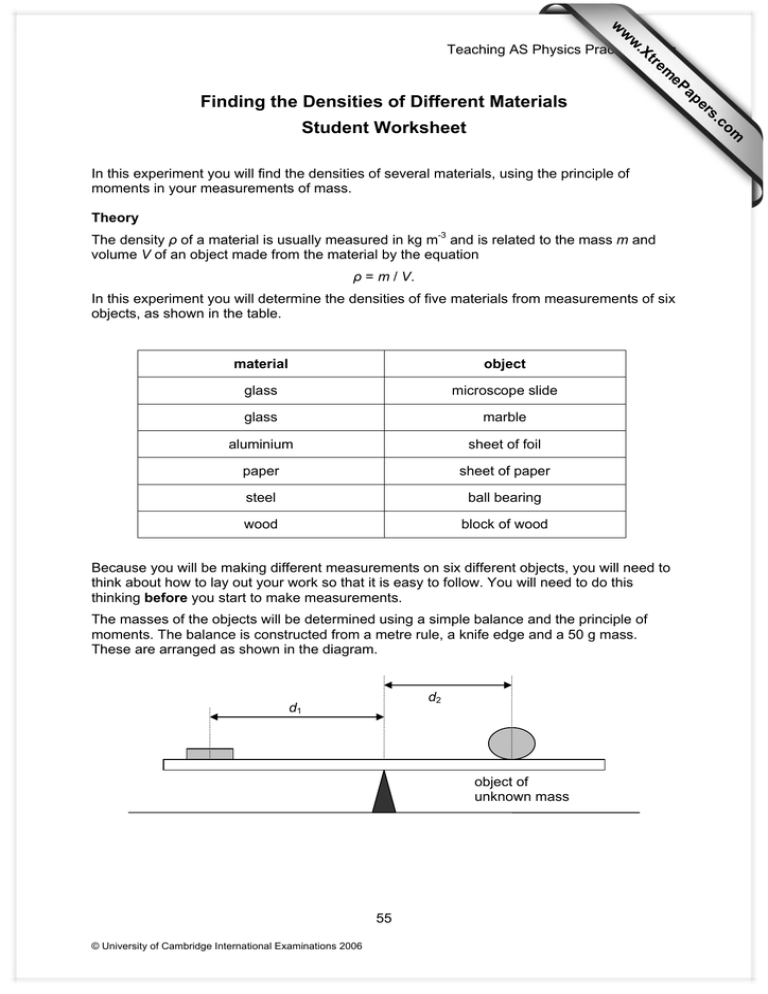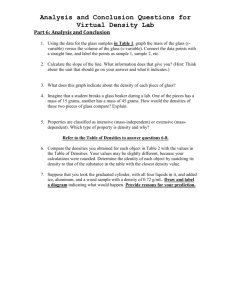Finding the Densities of Different Materials Student Worksheet www.XtremePapers.com
advertisement

w w w om .c Student Worksheet In this experiment you will find the densities of several materials, using the principle of moments in your measurements of mass. Theory The density ρ of a material is usually measured in kg m-3 and is related to the mass m and volume V of an object made from the material by the equation ρ = m / V. In this experiment you will determine the densities of five materials from measurements of six objects, as shown in the table. material object glass microscope slide glass marble aluminium sheet of foil paper sheet of paper steel ball bearing wood block of wood Because you will be making different measurements on six different objects, you will need to think about how to lay out your work so that it is easy to follow. You will need to do this thinking before you start to make measurements. The masses of the objects will be determined using a simple balance and the principle of moments. The balance is constructed from a metre rule, a knife edge and a 50 g mass. These are arranged as shown in the diagram. d2 d1 object of unknown mass 55 © University of Cambridge International Examinations 2006 s er Finding the Densities of Different Materials ap eP m e tr .X Teaching AS Physics Practical Skills Teaching AS Physics Practical Skills Densities of different materials Student Worksheet Without the 50 g mass or the object of unknown mass, the metre rule is balanced on the knife edge. Without changing the position of the knife edge under the rule, the 50 g mass and the objects are placed on the rule and their positions are adjusted until the rule balances. From the principle of moments, it can be shown that m1d1 = m2d2 where m1 = 50 g, m2 is the unknown mass, d1 is the distance from the pivot to the centre of the 50 g mass and d2 is the distance from the pivot to the centre of the unknown mass. Making measurements and observations 1 Use the 30 cm rule to measure the length and width of the sheet of paper. You should repeat your readings at different points and average the results. 2 Fold the sheet of paper in half several times. Make a note of how many layers are in the folded sheet. 3 Use the micrometer screw gauge to measure the thickness of the folded sheet. Repeat your readings at different points and average the results. 4 Use your answers in 2 and 3 to calculate the thickness of a single sheet of paper. 5 Repeat 1 – 4 to find the dimensions of the sheet of aluminium foil. 6 Use the 30 cm rule and the micrometer screw gauge as appropriate to measure the dimensions of the microscope slide and the block of wood. 7 Arrange the glass marbles in a straight line and touching each other, as shown in the diagram. 8 Use the two set squares and the 30 cm rule to measure the length of the row of marbles. 9 Divide your answer to 8 by the number of marbles to obtain the average diameter. 10 Divide this figure by two to obtain the average radius r of the marbles. 11 Repeat 7 – 9 for the steel ball bearings. 12 Balance the metre rule on top of the knife edge. Make a note of the position of the knife edge on the scale of the metre rule. 13 Place the 50 g mass and the microscope slide onto the metre rule, as shown in the diagram in the theory section. You may need to use a small piece of Blu-tack to prevent the microscope slide from falling off the metre rule and breaking. The position of the knife edge under the metre rule should not change and the positions of the 50 g mass and the microscope slide should be adjusted so that the metre rule balances on the knife edge. 14 Measure and record the distances d1 and d2. 15 Repeat 13 and 14 for each object. You may need to use a smaller mass for some of the objects. 56 © University of Cambridge International Examinations 2006 Teaching AS Physics Practical Skills Densities of different materials Student Worksheet Recording and presenting your data 1 For each object, record all the measurements you have made in a clear way, including the calculation of density. You will need to think about how you lay your work out before you start taking measurements. Remember to leave space for the analysis of your data. Analysing your data 1 Calculate the mass m2 of each object using the equation m1d1 = m2d2. 2 Calculate the volume V of each object. For the glass marble and the steel ball bearing, use the equation V= 4 3 πr 3 where r is the radius of the sphere. 3 Calculate the density ρ of the material from which each object is made, using the equation ρ= m . V Evaluation 1 Suggest, with a reason, the measurement that was the largest source of error in the calculation of the density for each object. 2 Suggest ways in which the accuracy of the experiment could be improved. 57 © University of Cambridge International Examinations 2006 Teaching AS Physics Practical Skills Finding the Densities of Different Materials Teaching Notes Link to theory 9(a) define the term density Key learning objectives • To gain familiarity with applying the principle of moments. • To familiarise students with density values for common materials. • To gain confidence in using micrometers. Notes In many cases the measurements that the students will take for the volume of the object may seem straightforward and may well be something that they have done before. It is important to stress that the degree of accuracy in their measurement needs to be very high and the steps that they need to take in order to get accurate measurements. Some students may not find it easy to balance the meter rule and may need encouragement and support. One objective of this experiment is to develop their manual dexterity in situations like this. It is worth encouraging them to spend some time getting used to the apparatus before attempting to make accurate measurements. Expected results material approximate density / kg m-3 glass 2000 - 4000 aluminium 2700 steel 7800 paper 600 - 1200 wood 150 - 1200 Possible extension work Students could be asked to look at the density values for the glass marble and glass microscope slide and to try and comment as to whether they are (or could be) made from the same material. They could be asked to complete the same experiment for irregular objects that still require precision measurement, e.g. a rubber hose such as one used to connect a Bunsen. This will require students to measure an internal and external diameter in order to calculate the volume of the tube. Blocks that are used to find the specific heat capacity of materials can be used as they require students to measure internal diameters and depths in order to calculate the volume of the block. 58 © University of Cambridge International Examinations 2006 Teaching AS Physics Practical Skills Finding the Densities of Different Materials Technical Notes Apparatus requirements 1 Sheet of aluminium foil. This should be neatly cut into a rectangle. The size should be greater than 10cm x 15cm in order to allow it to be folded over several times. It is important to get the edges as straight as possible. 2 Sheet of paper. Normal A4 writing paper will be fine although any rectangular size with straight edges will be fine. 3 Glass microscope slide. 4 Six identical steel ball bearings. 5 Six identical glass marbles. 6 Rectangular block of wood, with a mass of less that 200 g. 7 Blu-tack. 8 Two set squares. 9 Metre rule. 10 30cm rule. 11 Knife edge. This can be a glass prism or any other edge that can be placed on a table and have a metre rule balanced on it. 12 50 g mass. 13 10 g mass. 14 Micrometer screw gauge. Notes Students need to be warned about the dangers of over-tightening the micrometer screw gauge on the microscope slide. 59 © University of Cambridge International Examinations 2006


